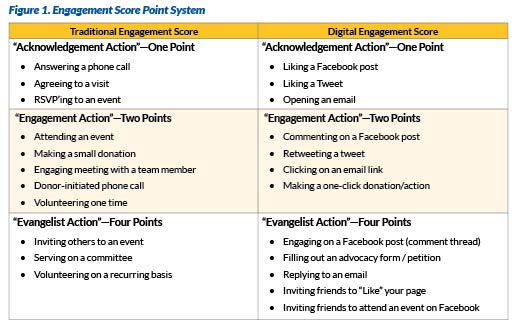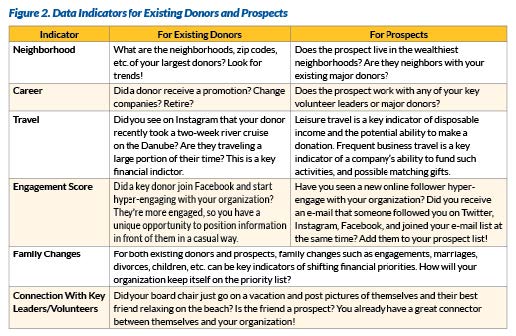The following magazine article appeared in the April 2020 issue of Advancing Philanthropy Magazine, the professional trade journal of the Association of Fundraising Professionals with a circulation of more than 30,000.
 With every interaction with a prospect, donor or persona, you receive and process new information about them. Seeing their activities on social media or in the newspaper, or talking with them at an event, a phone call, face-to-face meeting or a volunteer activity, provides you with valuable information about their interests and level of support for you and other key priorities in their life.
With every interaction with a prospect, donor or persona, you receive and process new information about them. Seeing their activities on social media or in the newspaper, or talking with them at an event, a phone call, face-to-face meeting or a volunteer activity, provides you with valuable information about their interests and level of support for you and other key priorities in their life.
As you garner information from these sources, what do you do with it? More importantly, how can it help you achieve your fundraising goals?
Here we explore three ways to structure how your organization can process this information in a way that drives donor engagement, encourages greater philanthropy and urges better data collection.
1. Deeper Donor Data
If you’ve attended any Fundraising 101 presentation, you’ve probably seen the donor cycle. From identification to qualification, cultivation, solicitation and finally stewardship, the cycle continues throughout the life of your organization- donor relationship. But if you think about what happens every time someone moves from phase to phase, you’ll find a re-qualification step where you re-evaluate and assess what has changed about your donor relationship to move them to the next phase.
Before we get into the tactics, it’s important to note that these steps can work in virtually any database solution, including pen and paper. Also, don’t use pen and paper!
In addition to the fields on your standard donor profile sheet, be sure to add the following information at each re-evaluation phase:
- How did they get from the previous phase to the new phase?
- How do they get information about your organization? Has this changed? Are there any new channels they are using to get information about your organization?
- Why do they care about your cause? (NOT your organization, the cause)
- What program, service or other attribute about your organization would the subject be interested in supporting? Has that changed recently and, if so, how?
Not only will regularly tracking these indicators help you build a more comprehensive donor file, it will help recognize trends in how these prospects and donors regularly engage with your organization.
2. Create Digital Engagement SCORES AND INDICATORS
Assigning point values to engagement activities is nothing new. In fact, the whole fundraising discipline of ‘moves management’ depends on scoring and indicators to establish predetermined steps in the organization’s advancement strategy. Moves management is a system of policies, procedures and practices that directs the actions an organization takes to increase donors and donations. A simple example of this is establishing a threshold amount at which a donation warrants a formal letter, handwritten note, phone call or personal visit. In larger development offices, a moves management trigger may be when a donor’s total giving crosses $50,000, and they are then assigned a dedicated major gift officer.
Today, your prospects and donors are engaging with your organization (and others) online on an hourly basis. Yet, too often organizations disregard or minimalize engagement on their online activities, leaving the “Facebook stuff” to the team member who most manages their accounts.
Investing in software solutions that track donor activity on LinkedIn, Twitter and Facebook is well worth it. Now, assuming you don’t have the ability to track these activities automatically, you can take a sample of your prospects and donors, starting with 20–25 people who already follow your Facebook page and engage regularly.
Note: For all the evangelizing I might do about technology, when getting started it may make sense to grab a cheap notebook from the dollar store to track these people for a period of a month or so. Create an engagement point system that works for your information, then determine at what point level additional direct engagement is warranted. The examples in Figure 1 can be used as a starting place.

3. Data Digging
Using a wealth screening service can help your organization not only determine a person’s capacity to give, but provide key indicators to engage your donors (See Figure 2).

Another important tactic of data digging is finding indicators that I like to call “Makes Sense” indicators—a more strategic version of common sense. These indicators are largely intuitive and not always reliable.
Sources of these “Makes Sense” indicators include existing donor data, public information, social media and online sources, other organizations, annual reports, program books from events, 990 forms, etc.
A Word on the Ethics of Online Research
From a technical standpoint, the information involved in wealth screening, a subset of prospect research, is all public information, such as real estate ownership, business affiliations, stock holdings in public companies, etc. From an ethical standpoint, your organization must look at the information it will use and how.
Keep in mind a few things:
- When someone signs up for Facebook, Instagram, Twitter, they are waiving their rights to privacy for anything they post. (“Everything you post online is fair game.”)
- Despite waving their rights, individuals have an expectation of privacy around this information.
- A prospect or donor will have an expectation that you will share where you obtained information about them, and may have the right to see their donor file at any time, depending on local, state/provincial and national laws.
- Section 10 of the Donor Bill of Rights states “A donor has the right to ask questions when making a donation and to receive prompt, truthful and forthright ”
Put simply, if a donor asks, “How did you know I went on that vacation?” or “How did you know that I’m going through a divorce?” things could get very uncomfortable very quickly if you’re not prepared to discuss openly your organization’s data gathering, management and storage policies. Consult the AFP Code of Ethical Standards for guidance.
Final Thoughts
As I stated at the beginning of this article, every interaction you have with a donor or prospect is an opportunity. At every stage of the donor cycle, you should consider what to document and what actions happen at key “moves management” points. And remember: By keeping excellent records and regularly using engagement scoring, you can drive donor development through your database deep dives.

